Want to attract top talent to your company? While many factors impact the type of candidates who will apply to work for you, few are as influential as the job ad you post.
The copy, format, and style of your job ad can all make or break candidates’ initial experiences with your company. Your job ad can ultimately convince an incredible candidate to hit “Apply”… or seek a job at one of your competitors instead.
Keep in mind that your job advertisement needs to stand out from the hundreds of thousands posted every month.
So how exactly can you create the perfect job advertisement template?
In this guide, you’ll learn precisely how to write a job posting ad. You’ll discover expert tips to ensure that you have the knowledge and tools to create a job advertisement that connects your company with top talent. We’ll also share some job advertisement examples of effective job ads from some of our clients.
Ready to learn more? Let’s get started!
What is a Job Advertisement?

Before we teach you how to create a job advertisement that will have candidates scrambling to apply to, let’s get the basics down first. What exactly is a job advertisement?
A job advertisement communicates a company’s intent to hire a professional to perform a specific role at the company.
A job ad is a notification to job seekers that communicates a company’s intent to hire a professional to perform a specific role at the company. A company publishes a job ad with the goal of attracting suitable candidates for the given role.
Once they receive the job applications, the company can review them based on how well each candidate’s profile matches that needed to be successful in the role.
Why is it Important to Craft a Strong Job Advertisement?
As we touched on above, a job advertisement will impact the type of candidates who apply to work at your company.
Put simply, if you create a strong job ad, you’ll be able to attract strong candidates. By this, we mean that you’ll receive applications from candidates who not only align with your company’s vision and values, but also have the professional experience, knowledge, skills, and other qualities to excel in the advertised role.
If you don’t make a strong job ad, you’re essentially setting your recruitment process up for failure.
And if you don’t make a strong job ad? Well, you’re essentially setting your recruitment process up for failure. If your job ad isn’t strategically pieced together, you’ll find yourself wading through subpar applications. Even if it manages to attract a large number of applications, the quality will be lacking.
Getting a large quantity of quality applications all boils down to creating a strong job advertisement. Here are the nine steps you will need to take to get this right:
1. Define the Role
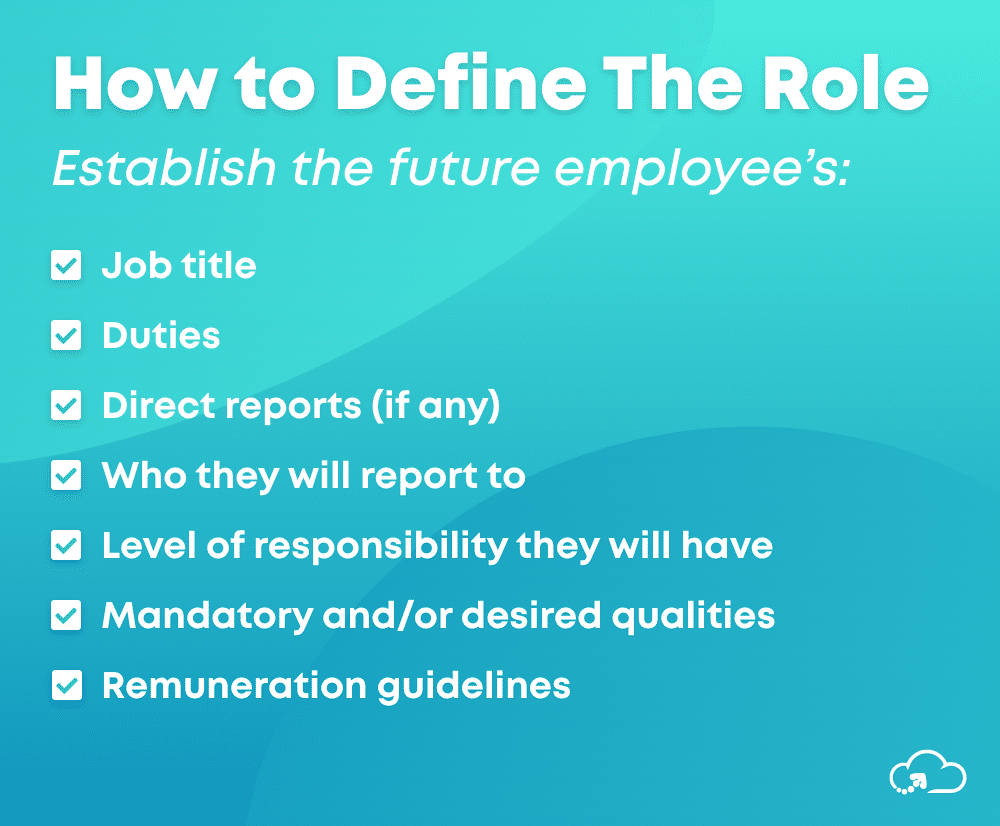
Before you even begin creating your job advertisement template, you need to spend time defining the role you wish to hire for.
If this sounds like obvious advice, think back to how many vague, confusing, or contradictory job advertisements you’ve come across. Those qualities are a clear indication that the person responsible for making the job posting didn’t spend the necessary time defining what and in turn, who, they’re looking for.
You should establish the future employee’s:
- Job title
- Duties
- Direct reports (if any) and who they will report to
- The level of responsibility they will have
- The mandatory and/or desired educational background, skills, experiences, licenses, certifications, etc. they should have
- Remuneration guidelines
To get this right, all of the key stakeholders related to the job should be consulted. This may include the hiring manager, department head, executive team, and CEO. To create a strong job ad, everyone needs to be on the same page about what the role entails and the type of candidate that will most likely be suitable.
2. Get the Job Ad Format Just Right
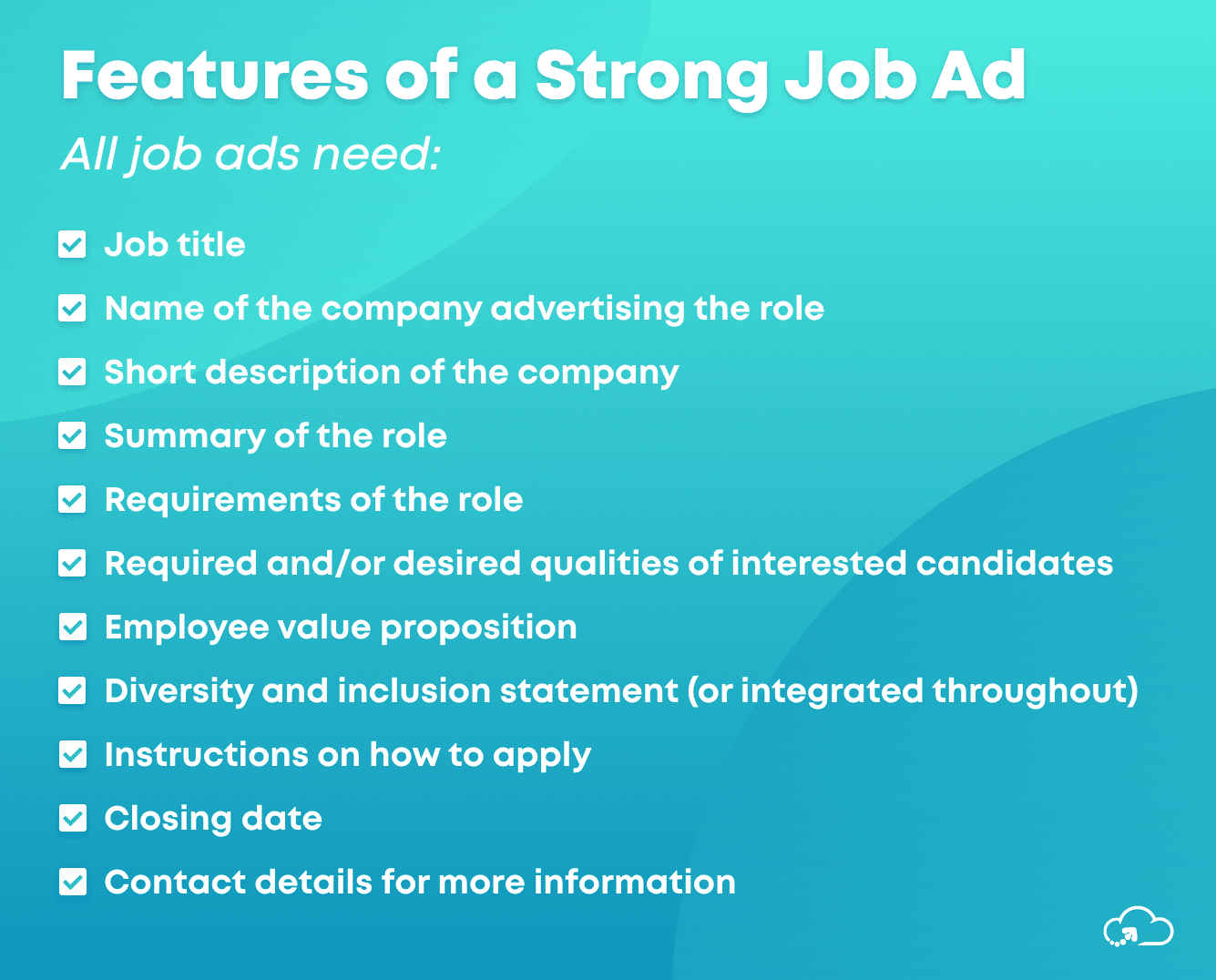
Every company has certain liberties they can take when it comes to the contents of a job advertisement.
At minimum, your job ad should make the ‘3 Rs’ of the position clear: the role, responsibilities, and requirements.
A good rule of thumb to keep in mind is that—at minimum—your job ad should make the ‘3 Rs’ of the position clear: the role, responsibilities, and requirements.
However, if your end goal is to attract top talent, you’ll need to go beyond the bare minimum.
Our experts believe the following components are standard features in every strong job posting. That is:
- The job title
- The name of the company advertising the role
- A short description of the company
- A summary of the role
- The requirements of the role, including who the employee will report to
- The required and/or desired qualities interested candidates should possess (e.g. educational background, professional experience, soft and hard skills, licenses and certifications, etc)
- Employee value proposition
- Diversity and inclusion statement (or integrated throughout)
- Instructions on how to apply
- The closing date
- Contact details for more information about the role
3. Share Who You Are as a Company
Job advertisement copy (that is, the content of the job ad) should communicate to candidates not only who you’re looking for, but also who you are as a company.
After the job title, you should paint a vivid picture of your company—its purpose, people, and values.
A simple format to follow is to provide a brief overview of your:
- Company history: When it started, who founded it, etc.
- Claim to fame: The products and/or services the company is known for.
- Company’s values: The set of values that define the company.
- Key statistics: Any eye-catching statistics that highlight the company’s achievements.
Think of it as your elevator pitch to candidates. It’s best to assume that they’ve never heard of your company before, as this will help you to provide an engaging and accurate summary of it.

Screenshot of Lactalis Australia’s company description in their job ad.
Take a look at the screenshot above of Lactalis Australia’s company overview section that features in all of its job ads. You’ll quickly notice that they’ve ticked all of the boxes we mentioned above.
It’s up to you what you choose to highlight about your company. But just remember that candidates refer to this section to see if your company’s history, goals, achievements, and values match up with those they’re looking for in their next job.
4. Clearly List Out the Role’s Key Responsibilities
It’s also vital to work on refining your description of the role at hand. You should do so until it sounds just right. Of course, what “just right” means is subjective. What works for one company may not work for another.
That’s why Peter Lewis, Senior People & Culture Business Partner at Data Action, believes in the importance of writing accurate job advertisements.
Always describe the role in a transparent and truthful way.
“Your description of the role should always be transparent and truthful,” Peter says. “Create a focused list of the actual requirements of the role so that candidates know what to expect.”
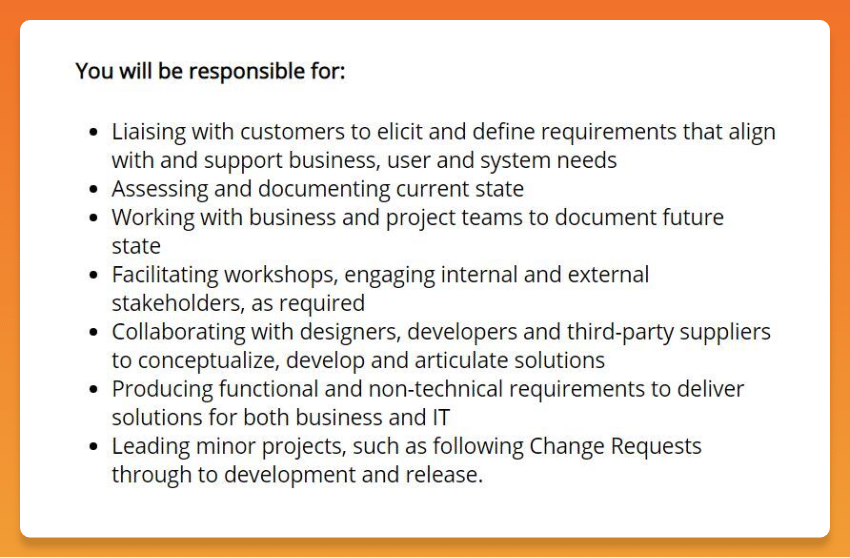
A screenshot of Data Action’s job advertisement highlighting a Business Analyst’s job responsibilities.
Peter feels strongly about the need to set clear expectations for candidates from the get-go. His number one tip for writing strong job descriptions is to “remember that you’re not searching for a unicorn.”
Remember that you’re not searching for a unicorn.
“You need to write the ad for a specific role in mind and the correct market,” he says. “If you’re advertising for a technical role, make sure to clearly state the specific technical requirements needed to succeed.”
The screenshot above shows that Peter practices what he preaches. It sets out the specific responsibilities attached to a Business Analyst role that Data Action is advertising for.
When writing the responsibilities section for your next job advert, make sure to follow suit.
Here are some tips to be mindful of:
- Use short, sharp bullet points.
- Lead with a verb e.g. manage, design, analyse, liaise, review, write, assess, research, etc.
- Include specific tasks the employee will need to spearhead or assist with.
- Include which other people, groups, or departments will be involved (if relevant).
- Mention the specific tools and programs the employee will need to use if known.
5. Describe Who You’re Looking For
This is one of the most important sections of a job ad. It should establish which qualities you’re seeking in an ideal candidate.
So what should this look like?
Below is a glimpse at a real job advertisement example for a Social Media Manager at MyRecruitment+.
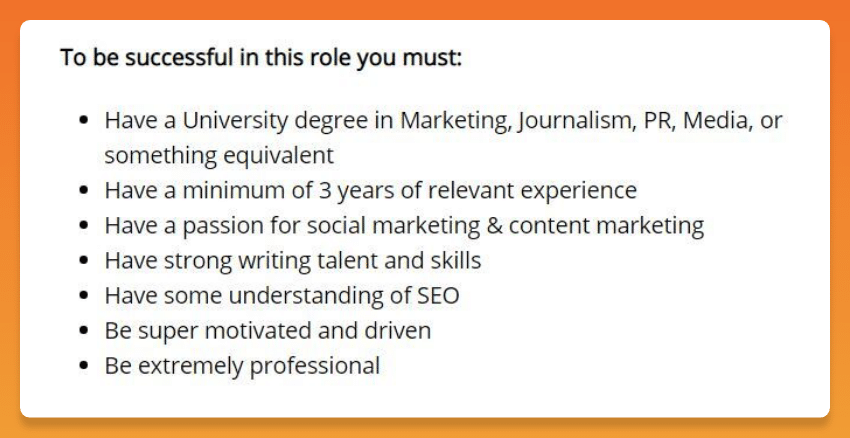
A screenshot of a job ad for a Social Media Manager at MyRecruitment+ that describes an ideal applicant’s profile.
Reading it, you’re able to visualise the type of candidate that would be a good fit for the position. That is, they need to have a certain educational background (or equivalent experience) and at least 3 years of professional experience. They also need to possess certain hard and soft skills.
If you want to create an equally impressive description, make sure to include the following:
- Educational background: The degree or diploma needed to fulfil the job requirements, if applicable.
- Years of experience: The type and number of years of professional experience the candidate should possess, if applicable.
- Hard skills: The technical skills needed to fulfil the job requirements e.g. SEO, Python, C++, typing speed, business analytics, bookkeeping, report writing, etc.
- Soft skills: The personal attributes needed to fulfil the job requirements e.g. strong communication skills, ability to multitask, professionalism, leadership, etc.
- Licences and certifications: The licenses and certifications needed to fulfil the job requirements e.g. CPA, CompTIA Security+, heavy vehicle licence, first aid certification, etc.
- Any other requirements: Any additional requirements attached to the role e.g. must own a car, availability to work weekends, willingness to travel frequently, etc.
6. Provide an Employee Value Proposition
What employee rewards and benefits does your company provide that make it a great place to work?
Try to put yourself in job seekers’ shoes when making your employee value proposition.
The most enticing ones should go in the employee value proposition section of your job ad. While you may believe that the opportunity to work for your company is enough of a privilege in itself, try to put yourself in job seekers’ shoes.
They are viewing job ad after job ad, comparing and contrasting each company’s offerings. One part of the total package they will consider is the rewards and benefits they can look forward to once they start at the company and/or perform well.
Take a look below at Ausdrill’s employee value proposition in their job ads.

Ausdrill’s employee value proposition featured in one of their advertised positions.
You can see that they offer a range of benefits for employees such as a competitive salary, employee incentives, a benefits and rewards program, and training and development opportunities.
Other benefits you may wish to include in your employee value proposition section include:
- Flexible working arrangements
- Bonuses
- Share options
- Mentoring opportunities
- Corporate discounts
- Gym discounts
- Free breakfasts, coffees, etc.
In this section, you may also wish to highlight your company’s diversity and inclusion initiatives, and/or encourage candidates from different backgrounds to apply.
Another option is to include a diversity and inclusion statement at the end of the posting, as SBS has done in all of their job ads:

Screenshot of SBS’s diversity and inclusion statement in a job advertisement.
And let’s not forget about the elephant in the room: remuneration. It is at your discretion whether you wish to indicate the remuneration for the role.
According to Peter, this is an incredibly contentious topic in HR circles. Some HR professionals prefer to list the salary or a salary range in a job ad, while others prefer to omit it entirely.
7. Provide Instructions on How to Apply
Do you want candidates to email their resume and cover letter to you? Or should they upload these documents directly to the given job board or your careers portal?
Should they answer specific questions about their skills and experience in their application? Upload a video recording? Include links to three published pieces?
As you can see, the task of deciding which instructions to provide interested candidates isn’t as straightforward as it may first seem.
Don’t create unnecessary hurdles for applicants to jump through.
The key thing to keep in mind is to make your instructions clear and fair. It’s entirely reasonable to ask candidates to provide more information about themselves or to explain why they’re a good fit for the role. But don’t create unnecessary hurdles for them to jump through. If you do, you risk missing out on hiring your dream candidate.
8. Make it Your Own
Remember how we said that there are hundreds of thousands of job advertisements posted every month?
To capture the attention of amazing candidates, you’ll need to stand out from the crowd. The following three simple but effective tips will help you put your company’s stamp on the job ads you publish.
- Add your logo to the top of each job post.
- Ensure your copy reflects your brand voice.
- Don’t use generic job descriptions copied from other job ads. Make each part specific to your company and the role at hand.
9. Decide Where to Post it
When it comes to the question of where to post your job advertisement, the answer is simple. The more places you post it, the more exposure it will get. The more exposure it gets, the higher the chances that it will get the attention of the types of candidates you’re looking for.
Some companies choose to only post jobs to their careers page, while others post only on job boards. There are also many companies that post on both.
If you plan to post your job ad externally, keep in mind that job boards all offer different qualities that you’ll need to consider.
For example, you can choose from job boards that are:
- Free or paid
- Industry-specific or general-purpose
- Australian or international
They also vary in the amount of flexibility you can have with deciding on formatting and stylistic elements.
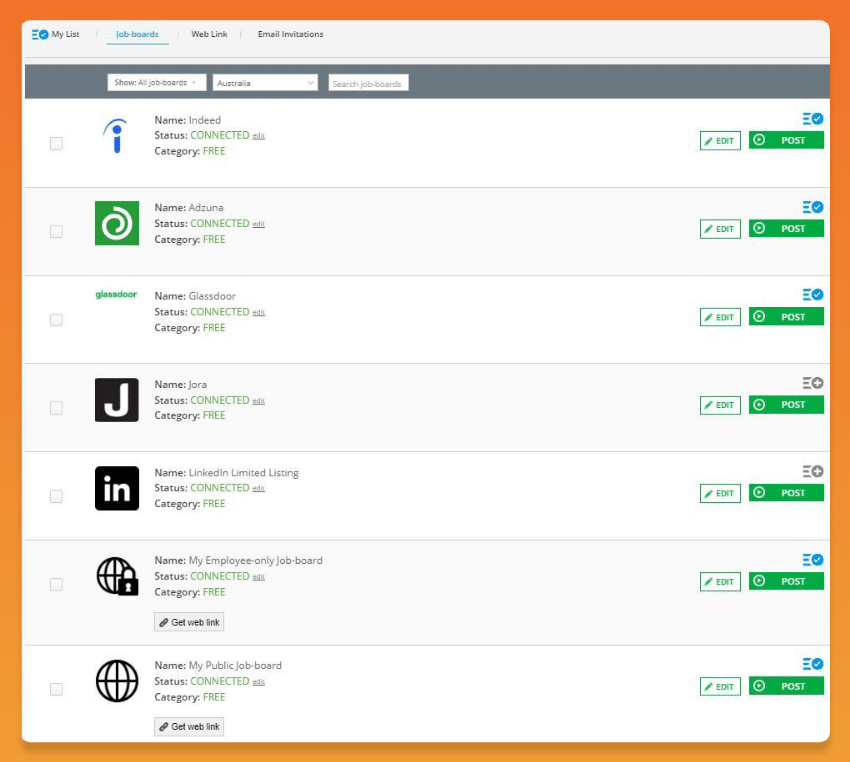
A peek at the MyRecruitment+ job board posting function.
Wherever you choose to post your job ad, MyRecruitment+ can make the whole process a breeze. Once you sign up to your free MyRecruitment+ account, it only takes a few minutes to create a job advertisement using our easy-to-use platform.
It’s easy to post your job ad on your website or on multiple job boards using your free MyRecruitment+ account.
When you’re ready to make it live, you can just select which paid and free job boards you wish to post it on. Our platform features over 30 paid and free job boards in Australia, including Indeed, Seek, LinkedIn, Gumtree, and more. There’s also the option to post it on international job boards, or social media sites like Facebook and Twitter.
And if you want to post it to your own public job board or your employee-only job board? You can also do that on the MyRecruitment+ platform with the click of a button
Conclusion
In this guide, we’ve outlined the precise steps you need to take to make the perfect job advertisement template. We’ve shared expert tips for sharpening your job ad, and even highlighted some real-life examples from our clients’ job ads.
When you’re ready to create your own one, we encourage you to refer back to this guide. It will give you the guidance and encouragement you need to succeed. It can be daunting to create your first job ad, or to change how you’ve been doing them, but with our tips and tricks, you’ll be onboarding top-tier talent in no time!
Do you have any other tips about how to make an amazing job ad? Share them in the comments!

